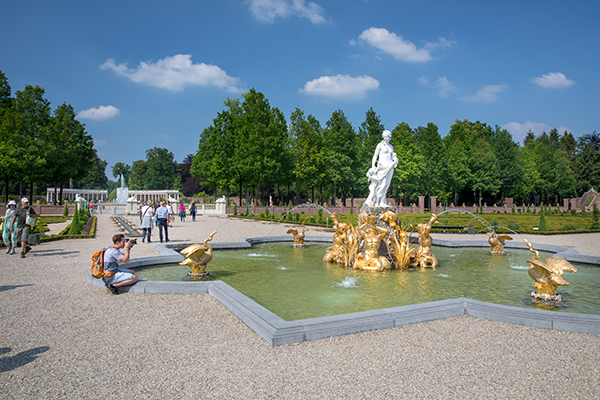Paleis Het Loo is located on the edge of Apeldoorn. Since 1984 is (former Royal) Paleis Het Loo a museum. The furnished rooms and chambers show how the Oranges have lived and worked here for 300 years. The baroque gardens have a symmetrical design, taking the garden of the 17th century as an example, and are unique in the Netherlands. The stables and coach houses are located at the Stables Square, which was built by order of Queen Wilhelmina (1880-1962). More than 30 years after opening, major maintenance was necessary and the palace itself is closed to visitors. Until then, the baroque gardens and the Stables Square can still be visited during the BuitenGewoon Open season until September 26, 2021.
The palace gardens
The gardens of Paleis Het Loo are reconstructed to the original 17th-century design of King-stadtholder William III and his wife Queen Mary II, the founders and first inhabitants of Paleis Het Loo. A Dutch Baroque garden, with many symmetrical parterres, impressive fountains and historical planting- as befits a baroque garden. The gardens were intended to give prestige and status to William and Mary and impress their guests.
In the early 19th century, the baroque gardens were covered with sand and – in style with the garden trends – made into a landscape park. With winding paths, groves, shrubs and many species of trees. The contrast with the 17th century palace gardens couldn’t be greater. In the 1980’s the garden was remodelled to its original Baroque style. Historical as well as contemporary flowers bring atmosphere to the palace gardens in each season.
Mythology in paradise
Compared to the gardens in Versailles, those at Paleis Het Loo are more modest in scale. The fountains, however, always spout fresh water thanks to the high level of the ground water, surpass the French ones. The Koningssprong [King’s Leap] was, with its 13 metres, the highest spouting fountain in Europe.
The garden sculptures, gods and goddesses from Greek mythology, all reflect on the theme of growth and flowering of the gardens and emphasise the achievement of turning what was originally a dusty stretch of heathland into a magnificent garden. In the centre stands Venus, the goddess of love.
The mythological statues and fountains are the elements of paradise, in reference to the gardens of 17th century gardens nostalgia. The planting in this last BuitenGewoon Open season is a mix of authentic planting and contemporary flowers and plants.
The BuitenGewoon Open season is still in full swing until September 26, 2021. After which the gates of the gardens and the Stables Square will be closed until the next season.
Visitors can reserve tickets with time slots on the website of Paleis Het Loo, after which everyone can stay and enjoy the whole day.
